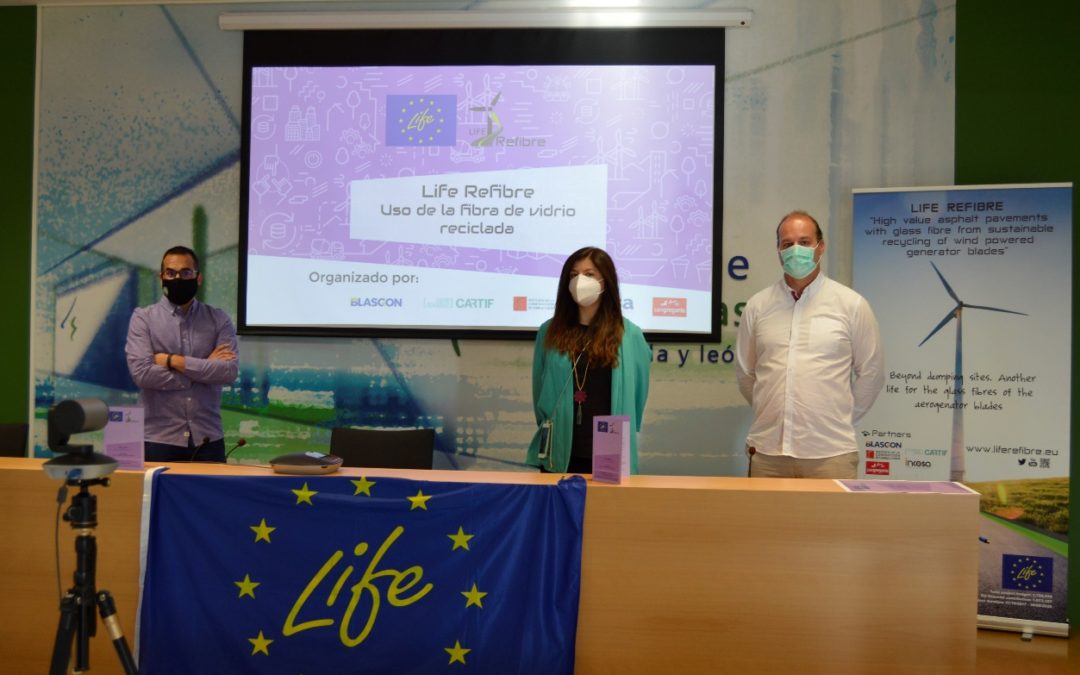On September 11st, the fourth workshop of the LIFE REFIBRE project – Uses of recycled glass fibre, organized by BLASGON, with the participation of the rest of the project partners (CARTIF, ICCL, INCOSA, SAN GREGORIO) was held.
What is glass fibre? Where is it used? Is its recyclability possible? In the near future we will find tons of waste to manage.
The 4 LIFE REFIBRE workshop sought to convey the importance of the circular economy by publicizing the different uses of recycled fiberglass as an innovative process.
The LIFE REFIBRE project once again organized a novel workshop led by the best experts, with the aim of sharing knowledge about different techniques for the application and reuse of composites that are currently being applied. We sought to provide first-line information to all online attendees. This new form of presentation has served to reach a wider variety of audiences and to be able to convey in a more accessible way the virtues of the circular economy and the advantages of R + D + i through the vision of industry, studies and European projects with practical examples.
With the title ‘Uses of recycled fiberglass’, professionals from different sectors gathered to present their experiences and work in different presentations throughout the morning. The day was divided into four themes. Initially, the National Circular Economy Strategy was discussed by Santiago Ramos, Founder of Reloops, who introduced the strategy and its importance, placing emphasis on the lines of action, objectives and indicators.
Then, the next block referred to the enhancement of innovation and specialization in the wind turbine sector. The block began with a presentation by Jorge de Blas, technical director at BLASGON – Civil Infrastructures and member of the LIFE REFIBRE project consortium, sharing the origins of the project idea and the value of collaborative innovation. The objective of the LIFE REFIBRE project is the integrated management of glass fiber reinforced plastic waste (GRP) that makes up the blades of wind turbines once their useful life has ended. LIFE REFRIBRE promotes the complete and high-quality recyclability of its main compound, fiberglass (64% total by weight), favoring the recovery of these wastes in favor of a reduction in their presence in landfills and providing them with a second cycle of life for a high added value application: its incorporation into asphalt agglomerate.
There was also David Romero, operations director of the company RECICLALIA SL, presenting the projects and objectives of the industry specialized in wind turbine recycling. Those who are not satisfied with the current solutions that exist in the face of the problem we are experiencing at levels of waste, always seek to provide a wide range of applications and possibilities to the sector.
Due to the importance of research in processes as a key in recycling materials, Ana Isabel Almerich Chulia, Doctor of Industrial Engineering from the Department of Continuous Media Mechanics and Structures Theory at the ETSArquitectura of the Polytechnic University of Valencia was invited to explain new techniques applicable to structures with the use of composites. On the other hand, Salvador Navarro, technical director in R + D + i projects at the Green World Compounding company, participated in order to deal with fiberglass reuse processes from the point of view of industrial research.
To end the event, we sought to publicize practical cases from the hand of two European H2020 projects. The first presentation was on the ECO-COMPASS project, thanks to the collaboration of Jens Bachman, scientific assistant at the German Aerospace Center (DLR) at the Institute of Composite Structures and Adaptive Systems in the Department of Multifunctional Materials, as the EU coordinator of the project . Second, there was the experience of the FIBRESHIP project under the Spanish coordination of TSI-Técnicas y Servicios de Ingeniería SL through the presentation of Alfonso Jurado, director of the department of R&D and innovation in the company.
In the following link, through the project’s youtube channel, it can be seen a summary of the workshop.




